| |
|||||
From Chaika to Chato
The I-15 entered series production during the spring of 1935. Manufacture continued through the end of the year, but was halted during the entirety of 1936, when no examples were built. The programme resumed in 1937 with the M-25A motor, and now a four-gun arrangement as standard (many M-22 powered aircraft had two PV-1 guns).
The I-15 was supplied in numbers to the Republican Government in Spain during 1936-37. However, the majority of I-15s serving in the Civil War were manufactured locally, in Spain, at one of two aviation factories. As a result, the exact colouration of many I-15s in Spain is unknown. Research is currently underway to determine the appearance of these Spanish aviation lacquers.
Another difficulty arises when examining anecdotal sources. For the I-15 in Spain, where it was nick-named the Chato ('blunt-nose'), the various testimonies of the appearance of the I-15 is usually for a "dark olive green" colour with "pale blue" undersurfaces. This description does not match Soviet aviation lacquers very well. Worse still, the anecdotal record of the procedures of paint use and application are astoundingly disjointed and contradictory. For the Chato, some claims are that Soviet paint was used; others insist that all machines were repainted in Spain; others still suggest various mixed practices.
When looking at the photographic record, it does seem that some facts emerge from the current muddle. It seems to be the case that at least two distinctive shades of green can be seen on period photographs on the I-15. Some authors have suggested a third colour, as well. Be that as it may, this difference is eminently logical. One would assume that aircraft manufactured in the USSR would be finished with Soviet lacquers, and those in Spain in Spanish manufactured paints. This observation would tend to support that idea.
For comparison purposes, here we have an example of VVS finish and a proposed
appearance for the unknown Spanish lacquers.
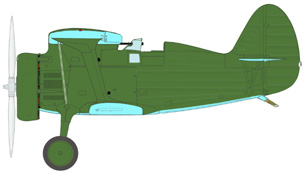 |
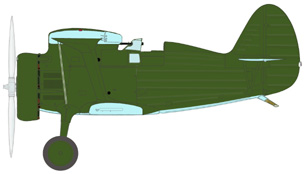 |
| Soviet lacquers 3B and AEh-4 | Spanish lacquers "Dark Olive" and "Pale Blue" |
Below, we present our first part of a series of articles on colourful I-15 aircraft. Hopefully many of these examples will be new, and offer fresh challenges and possibilities for modelers.
| I-15 M-22 "White 15" Squadron Cmdte. Leopoldo Morquillas 3e Esquadrille Balaguer, ca. 1937 |
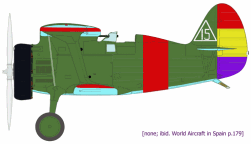 |
I-15 "White 15" was an early machine in Spain, and likely it was indeed delivered from the USSR. Morquillas was the leader of the 3rd Squadron, then based at Balaguer.
Being of Soviet manufacture, it seems most likely that this aircraft was finished in lacquers 3B over AEh-4. The aircraft lacked wheel spats (as was standard in Spain), and was armed with four PV-1 guns (interestingly, all known I-15s sent to Spain were completed with four guns). The cowling was alleged to have been black, but alas no photograph is available to confirm the idea.
The Republican markings on the upper wing surfaces appear to have been rendered
as a band of red colour, whilst on the lower wings as the 'tip' of the airfoil.
A medium sized band was applied to the fuselage, and the usual tri-colour rudder
was present, as well.
| I-15 M-22 "White 151" (CA-151) pilot u/k 3e Esquadrille Barcelona, ca. 1938 |
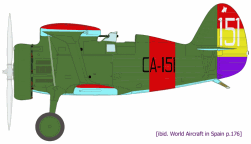 |
This machine was a member of the famous Patrulla de los Toros (The Bull Patrol) of the 3rd Squadron, then based at Barcelona. The pilot of this machine is not currently known.
"151" might have been manufactured in Spain, and as a result may well have been finished in Spanish lacquers. The profile above depicts Soviet colouration; modelers are encouraged to finish the scheme as they best see fit. The appearance is typical in most respects, and the serial number is giver on the fuselage in black using a typical Spanish font. The national insignia bands were presented as 'wing tip' applications on both upper and lower surfaces.
Most aircraft of the Patrulla de los Torros featured a small bull insignia
on the fin, and "White 151" does as well. The repetition of the serial number
on the rudder seems to have been common in the 3e Esquadrille.
| I-15 M-22 "Black 8" (8-100) pilot u/k Staff Flight, 33e Gruppo (?) Getafe, ca. 1945 |
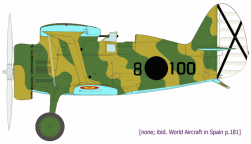 |
Alas, little is known of this particular aircraft, save that it was captured and put into service by the Nationalists, and was photographed at Getafe in 1945. The pilot of "8" is unknown.
This aircraft has been attributed variously over the years, and the best estimation now seems to be that it belonged to the Staff (or HQ) flight of the 33rd Group, then stationed at Getafe. The finish of this machine is not known, and this profile must be regarded as speculative. The finish might have been in Soviet (shown) or Spanish lacquers, over which some areas of a "sand" colour have been applied.
The rudder shows the traditional Franco-Nationalist rudder, as is similarly
the fuselage roundel. The wing upper and lower surfaces look to sport the new
type national marking with red and yellow discs.
| I-15 M-22 no number pilot Igor Kamentin 6 OIAE, 13 AB Moscow, ca. spring 1936 |
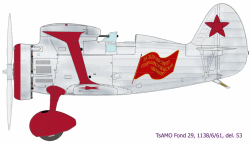 |
This lovely I-15 was piloted by one of the foremost Soviet pilots of the 1930s whose actions, sadly, are still largely unknown and anonymous. Igor Kamentin was a brilliant Pilot-Engineer cast very much in the Old School tradition. He was a graduate colleague of later NII VVS director Filin, and a strong proponent of the "pro-biplane" faction within the Air Force. Kamentin flew operationally with the 6 OIAE around Moscow, and also held a full Instructor position within the LII. He was deeply involved in the evolution of fighter tactics and operations during the 1930s, giving advanced tactical training to many VVS pilots of the time. Kamentin was set to travel to Spain with the early Soviet advisors when, tragically, he was killed in a flight accident before departing during July 1936 (a student pilot crashed into his aircraft). Kamentin was posthumously awarded the title Hero of the Soviet Union for his contributions to aviation and the Air Force.
The machine above was Kamentin's personal mount at the LII. The photograph showing this aircraft, within the TsAMO Fond 29 collection, is rather poor. What it looks to show are very lovely scarlet coloured details over an AII Aluminum finished aircraft--the interplane struts, cowl leading edge and gear spats being so painted. If the surfaces were indeed AII lacquer, then this strongly suggests that the aircraft was refinished after manufacture; M-22 manufactured I-15s were completed prior to the introduction of this varnish. The machine did appear to have a four-gun armament, however, which certainly would have been a logical outfit for an Instructor involved in fighter tactics.
The aircraft demonstrated some superb artwork on the port fuselage. The item is certainly a red flag which has been quite dramatically (and unusually) 'rippled'. The text is not at all clear, and I believe that it states "Da Zdravstvuet Sotsialisticheskaya Aviatsiya !" ('Hail to Socialist Aviation'); if a better view emerges, this text will have to then be verified. The national markings looked to have been of the somewhat 'old' early 1920's style, being rather rounded and fattened, and featuring a thin black outline and circle.
No appreciable wear was evident on this aircraft, which certainly befitted
its beautiful appearance. The view does not show the wing surfaces, but likely
the upper and lower, both, would have carried these odd national insignia.
| I-15 M-25A "White 6" pilot Anatoliy Komosa 15 IAP Pskov, ca. May 1938 |
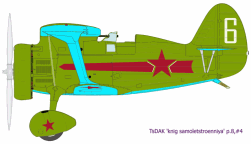 |
"White 6" was the personal mount of another leading figure in Soviet aviation--both prior to the outbreak of the Great Patriotic War, and during--but still largely unrecognized and unknown. Hero of the Soviet Union A. Komosa was a young Leytenant when he piloted this I-15 during 1937-38. He was recognized as an outstanding pilot from the start, and received training on the I-16 fighter during 1939, joining the 22 IAP in the Khalkin-Gol actions of that autumn. He later piloted LaGGs in the early Barbarossa period, commanded an eskadrilya within the illustrious 55 IAP (16 GIAP) mounted on the Yak-1, and finally was transferred to the command staff of the 2nd Air Army. Komosa finished the War with 23 + 11 confirmed victories as a Mayor, and died in 1952.
"6" is an example of I-15 manufacture during 1937, and was powered by the M-25A motor. The finish in this case was AII lacquers Green over Blue, and the details show the evolution of finishing practices during the year. Prior to this time, many aircraft with interplane struts had these units finished in the upper surface colour; but, during the year the routine changed, and finishing in the lower surface colour became predominate. This was the case with "White 6", which also carried wheel spats (which were increasingly rare during 1937). A miniature national star was applied to the spats, this at the so-called 'ground angle', and the tactical number was seen on the rudder, in white. A lovely stripe appeared on the fuselage, and this looks to have been trimmed with a thin white edge around the national star. The stabilizer struts, curiously, look to have been entirely unpainted.
This machine probably carried national markings on the wing upper surfaces,
as well. It demonstrates some wear in the photograph, and looks to be a used
service machine in all respects.
| I-15 M-25A "Red 2" pilot u/k 3 OIAO PVO Moscow, ca. 1937 |
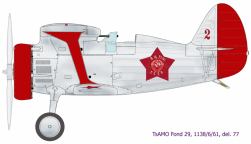 |
A number of very colourful I-15s were photographed serving around Moscow, and this machine, "Red 2", is another example. The caption states that "2" served in the PVO at Vnukovo during 1937, which certainly would mean (if so) that it belonged to the 3 OIAO PVO. The pilot is unknown.
This photograph is held within the very same folder as the picture of Kamentin's I-15 (see above), and is similarly poor, alas. Again, the photo looks to show over-all AII Aluminum colouration with scarlet details. In this case, the entire cowling looks to be so finished, as are the interplane struts, and also the rudder. The national star is of the pre-War 'bloated' variety, which is sometimes referred to as the "Award Type" star (as it resembles various Soviet military medals). The insignia carries a most interesting artwork which, given the lack of clarity of the picture, I believe to be the Great Seal of the USSR. Again, a better picture would help here. There is some text on the star, as well, and in this case it does certainly look to be "VKP(b) SSSR" (All-Union Communist Party of the USSR). The tactical number "2" is small, and appears on the fin in red.
"Red 2" lacked wheel spats, as was typical, and demonstrated some wear in the picture. The lower wing surface is just in view, and it looks to show 'circle-star' type national markings, which would be very common for this time; these markings would probably have appeared on the wing upper surfaces, as well.